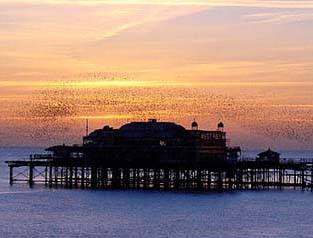The starlings - a spectular ritual


“One of the things that I love about living here is being able to watch the starlings flying above the West Pier just before sundown. I often walk along the seafront late in the afternoon and just stop and sit on the pebbles to enjoy the spectacle. Really, I’ve never seen anything like it. The contrast between the elaborate, derelict pier, the open sky, and the immense, pulsing mass of tiny birds is absolutely breathtaking. Sometimes as I watch it starts to look like a huge dot-animation projection or perhaps something like the patterns you get when moving metallic dust around with magnets. I’ve always found that it’s an enjoyable way to relax my mind and wind down at the end of the day.”
by Jenny Ridland, My Brighton and Hove volunteer, 2001
“This decaying relic stands as a symbol of Brighton’s decadent past, in striking contrast to the kitsch modern version that mirrors it a few hundred meters east. This alone merits its place as a prime sight of Brighton, but there is more…. at dusk it hosts a spectacular ritual. Literally hundreds of resident birds spend the sunset hour conducting a display of formation flight of collective consciousness, creating a kind of wonderful sight that is both inspiring and relaxing. For the best view, head to the Gemini bar and enjoy the show over an evening pint.”
by Benjamin Powis, student, 1998




Comments about this page
In reply to Gina Orselli’s comments: Starlings forage in the farmland, fields and gardens surrounding Brighton during the day and then congregate at dusk. They roost together for safety reasons as many individuals mean many pairs of eyes to look out for predators and their elaborate flight patterns can also confuse predators. The pier appears to be an ideal winter roost location: the isolation and therefore safety of the structure seems to outweigh its obvious exposure to the elements. We also have a large starling roost on the pier at Aberystwyth with many thousands of individuals congregating at dusk and then spreading out into the surrounding countryside at dawn. The most impressive flight patterns occur when a peregrine falcon attacks the flock. At such times the swirling pattern of the flocks of birds is truly amazing. One theory is that all of the starlings are trying not to be left on the outside of the flock and in their attempts to get away from the edge of the group these incredible formations occur. It appears that Aberystwyth and the West Pier in Brighton are the only two starling pier roosts in the country. All the more of a shame that the present owners of the pier in Aber are doing their best to scare the birds away with very bright halogen lights and loud explosion noises. Can anybody tell me if the number of birds using the pier appears to have fallen since the fire?
I think it’s also lovely and I have often sat and watched this sight. I would also be interested in knowing why they do this ritual.
Fascinating and very informative. I am going to make an effort to find a place where starlings roost and watch them one evening. I also feel that the Pier should be made a proper designated Starling Roost. There are very few places where they can roost these days without stinky polluting humans complaining about them! Imagine, if we weren’t top of the animal chain, what endless complaints could be made about humans by the ones at the top who might want to eradicate us! I get so fed up with ignorant people complaining about them making a mess – humans do so much worse things.
The morning after the first fire on the West Pier in 2003 I heard a strange scratching on my fire escape (I live in Norfolk Square). When I investigated I realised it was a couple of cheeky starlings ripping my herbs to pieces! After collecting a beakful of leaves and twigs they both flew off in the direction of the Pier. I had never seen them near my flat before and so can only assume that they were furiously collecting local bedding to replace their burnt out nests. They have never returned since and I like to think there’s now a quiet corner of the Pier that will alway smell sweetly of rosemary and sage!
Danny Ardeshir, 20-01-2004 comments ‘It appears that Aberystwyth and the West Pier Brighton are the only two starling pier roosts in the country’ – not so!! We live in Blackpool which boasts 3 working piers and we have witnessed the starling dances many many times on each pier. Last night (6th Feb 2005) we watched the starlings as we walked into town along the prom and this caused me to do some research this morning. They’re interesting little birds.
Just got back from watching the starlings swirl by the pier, its a truly awesome spectacle. Intrigued, I googled and found a webpage about how scientists think they manage such unity of movement. But still, why? Could it just be for the sheer joy?
Where are the starlings now? Someone I know wants to watch such a spectacle but I don’t know where to take them.
Barry, I also would love to see starling flocks anywhere in London or the South East. Anyone know where? Thanks in advance.
We are thinking of going to Brighton on or near 25th June. Do the starling roost on the pier this time of year?
Add a comment about this page